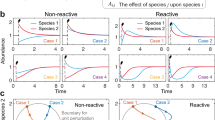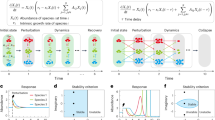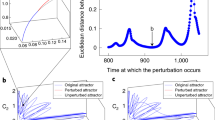Abstract
Random environmental variation, or stochasticity, is a key determinant of ecological dynamics. While we have some appreciation of how environmental stochasticity can moderate the variability and persistence of communities, we know little about its implications for the nature and predictability of ecological responses to large perturbations. Here, we show that shifts in the temporal autocorrelation (colour) of environmental noise provoke trade-offs in ecological stability across a wide range of different food-web structures by stabilizing dynamics in some dimensions, while simultaneously destabilizing them in others. Specifically, increasingly positive autocorrelation (reddening) of environmental noise increases resilience by hastening the recovery of food webs following a large perturbation, but reduces their resistance to perturbation and increases their temporal variability (reduces biomass stability). In contrast, all stability dimensions become less predictable, showing increased variability around the mean response, as environmental noise reddens. Moreover, we found environmental reddening to be a considerably more important determinant of stability than intrinsic food-web characteristics. These findings reveal the fundamental and dominant role played by environmental stochasticity in determining the dynamics and stability of ecosystems, and extend our understanding of how the multiple dimensions of stability relate to each other beyond simple white noise environments.
This is a preview of subscription content, access via your institution
Access options
Access Nature and 54 other Nature Portfolio journals
Get Nature+, our best-value online-access subscription
$29.99 / 30 days
cancel any time
Subscribe to this journal
Receive 12 digital issues and online access to articles
$119.00 per year
only $9.92 per issue
Buy this article
- Purchase on Springer Link
- Instant access to full article PDF
Prices may be subject to local taxes which are calculated during checkout





Similar content being viewed by others
Data availability
All core data, including the constructed communities, time series of environmental stochasticity and ecological stabilities, and R codes for generating the results and figures of this paper, are available at https://github.com/qiang-yang-ecology/Yang.et.al.stochasticity.stability.NEE.
References
Bellard, C., Bertelsmeier, C., Leadley, P., Thuiller, W. & Courchamp, F. Impacts of climate change on the future of biodiversity. Ecol. Lett. 15, 365–377 (2012).
Blois, J. L., Zarnetske, P. L., Fitzpatrick, M. C. & Finnegan, S. Climate change and the past, present, and future of biotic interactions. Science 341, 499–504 (2013).
Davis, A. J., Jenkinson, L. S., Lawton, J. H., Shorrocks, B. & Wood, S. Making mistakes when predicting shifts in species range in response to global warming. Nature 391, 783–786 (1998).
Oliver, T. H. et al. Biodiversity and resilience of ecosystem functions. Trends Ecol. Evol. 30, 673–684 (2015).
Petchey, O. L. et al. The ecological forecast horizon, and examples of its uses and determinants. Ecol. Lett. 18, 597–611 (2015).
Urban, M. C. et al. Improving the forecast for biodiversity under climate change. Science 353, aad8466 (2016).
Donohue, I. et al. Loss of predator species, not intermediate consumers, triggers rapid and dramatic extinction cascades. Glob. Change Biol. 23, 2962–2972 (2017).
Thompson, R. M., Beardall, J., Beringer, J., Grace, M. & Sardina, P. Means and extremes: building variability into community-level climate change experiments. Ecol. Lett. 16, 799–806 (2013).
Donohue, I. et al. Navigating the complexity of ecological stability. Ecol. Lett. 19, 1172–1185 (2016).
Vellend, M. The Theory of Ecological Communities (Princeton Univ. Press, Princeton, NJ, USA, 2016).
Boettiger, C. From noise to knowledge: how randomness generates novel phenomena and reveals information. Ecol. Lett. 21, 1255–1267 (2018).
Halley, J. M. Ecology, evolution and 1/f-noise. Trends Ecol. Evol. 11, 33–37 (1996).
Ruokolainen, L., Linden, A., Kaitala, V. & Fowler, M. S. Ecological and evolutionary dynamics under coloured environmental variation. Trends Ecol. Evol. 24, 555–563 (2009).
Vasseur, D. A. & Yodzis, P. The color of environmental noise. Ecology 85, 1146–1152 (2004).
Easterling, D. R. et al. Climate extremes: observations, modeling, and impacts. Science 289, 2068–2074 (2000).
Jentsch, A., Kreyling, J., Boettcher-Treschkow, J. & Beierkuhnlein, C. Beyond gradual warming: extreme weather events alter flower phenology of European grassland and heath species. Glob. Change Biol. 15, 837–849 (2009).
Kayler, Z. E. et al. Experiments to confront the environmental extremes of climate change. Front. Ecol. Environ. 13, 219–225 (2015).
Kuparinen, A., Keith, D. M. & Hutchings, J. A. Increased environmentally driven recruitment variability decreases resilience to fishing and increases uncertainty of recovery. ICES J. Mar. Sci. 71, 1507–1514 (2014).
Crone, E. E. Contrasting effects of spatial heterogeneity and environmental stochasticity on population dynamics of a perennial wildflower. J. Ecol. 104, 281–291 (2016).
Fowler, M. S. & Ruokolainen, L. Colonization, covariance and colour: environmental and ecological drivers of diversity–stability relationships. J. Theor. Biol. 324, 32–41 (2013).
Ruokolainen, L., Ranta, E., Kaitala, V. & Fowler, M. S. Community stability under different correlation structures of species’ environmental responses. J. Theor. Biol. 261, 379–387 (2009).
Donohue, I. et al. On the dimensionality of ecological stability. Ecol. Lett. 16, 421–429 (2013).
Pimm, S. L. The complexity and stability of ecosystems. Nature 307, 321–326 (1984).
Ives, A. R. & Carpenter, S. R. Stability and diversity of ecosystems. Science 317, 58–62 (2007).
May, R. M. Stability and Complexity in Model Ecosystems (Princeton Univ. Press, Princeton, NJ, USA, 1973).
Sabo, J. L. & Post, D. M. Quantifying periodic, stochastic, and catastrophic environmental variation. Ecol. Monogr. 78, 19–40 (2008).
Pimm, S. L. & Lawton, J. H. Number of trophic levels in ecological communities. Nature 268, 329–331 (1977).
Pimm, S. L. & Lawton, J. H. On feeding on more than one trophic level. Nature 275, 542–544 (1978).
Petchey, O. L., Eklof, A., Borrvall, C. & Ebenman, B. Trophically unique species are vulnerable to cascading extinction. Am. Nat. 171, 568–579 (2008).
Ruokolainen, L. & Fowler, M. S. Community extinction patterns in coloured environments. Proc. R. Soc. B 275, 1775–1783 (2008).
Estes, J. A. et al. Trophic downgrading of planet Earth. Science 333, 301–306 (2011).
O’Connor, N. E., Emmerson, M. C., Crowe, T. P. & Donohue, I. Distinguishing between direct and indirect effects of predators in complex ecosystems. J. Anim. Ecol. 82, 438–448 (2013).
White, L., Donohue, I., Emmerson, M. C. & O’Connor, N. E. Combined effects of warming and nutrients on marine communities are moderated by predators and vary across functional groups. Glob. Change Biol. 24, 5853–5866 (2018).
Bascompte, J. & Melian, C. J. Simple trophic modules for complex food webs. Ecology 86, 2868–2873 (2005).
Kondoh, M. Building trophic modules into a persistent food web. Proc. Natl Acad. Sci. USA 105, 16631–16635 (2008).
Milo, R. et al. Network motifs: simple building blocks of complex networks. Science 298, 824–827 (2002).
Clark, J. S. Uncertainty and variability in demography and population growth: a hierarchical approach. Ecology 84, 1370–1381 (2003).
Clark, J. S. Individuals and the variation needed for high species diversity in forest trees. Science 327, 1129–1132 (2010).
Laakso, J., Kaitala, V. & Ranta, E. Non-linear biological responses to environmental noise affect population extinction risk. Oikos 104, 142–148 (2004).
Ripa, J. & Heino, M. Linear analysis solves two puzzles in population dynamics: the route to extinction and extinction in coloured environments. Ecol. Lett. 2, 219–222 (1999).
Loreau, M. & de Mazancourt, C. Biodiversity and ecosystem stability: a synthesis of underlying mechanisms. Ecol. Lett. 16, 106–115 (2013).
Tilman, D. Biodiversity: population versus ecosystem stability. Ecology 77, 350–363 (1996).
Wang, S. P. & Loreau, M. Biodiversity and ecosystem stability across scales in metacommunities. Ecol. Lett. 19, 510–518 (2016).
Ives, A. R., Gross, K. & Klug, J. L. Stability and variability in competitive communities. Science 286, 542–544 (1999).
Kalinkat, G. et al. Body masses, functional responses and predator–prey stability. Ecol. Lett. 16, 1126–1134 (2013).
Kaneryd, L. et al. Species-rich ecosystems are vulnerable to cascading extinctions in an increasingly variable world. Ecol. Evol. 2, 858–874 (2012).
Berlow, E. L. et al. Simple prediction of interaction strengths in complex food webs. Proc. Natl Acad. Sci. USA 106, 187–191 (2009).
Van der Bolt, B., van Nes, E. H., Bathiany, S., Vollebregt, M. E. & Scheffer, M. Climate reddening increases the chance of critical transitions. Nat. Clim. Change 8, 478–484 (2018).
Scheffer, M. et al. Early-warning signals for critical transitions. Nature 461, 53–59 (2009).
Greenman, J. V. & Benton, T. G. The amplification of environmental noise in population models: causes and consequences. Am. Nat. 161, 225–239 (2003).
Murdoch, W. M., Briggs, C. J. & Nisbet, R. M. Consumer–Resource Dynamics (Princeton Univ. Press, Princeton, NJ, USA, 2003).
Mayfield, M. M. & Stouffer, D. B. Higher-order interactions capture unexplained complexity in diverse communities. Nat. Ecol. Evol. 1, 0062 (2017).
Cohen, J. E., Jonsson, T. & Carpenter, S. R. Ecological community description using the food web, species abundance, and body size. Proc. Natl Acad. Sci. USA 100, 1781–1786 (2003).
Brown, J. H., Gillooly, J. F., Allen, A. P., Savage, V. M. & West, G. B. Toward a metabolic theory of ecology. Ecology 85, 1771–1789 (2004).
Healy, K. et al. Ecology and mode-of-life explain lifespan variation in birds and mammals. Proc. R. Soc. B 281, 20140298 (2014).
Paine, R. T. Food-web analysis through field measurement of per-capita interaction strength. Nature 355, 73–75 (1992).
Wootton, J. T. & Emmerson, M. Measurement of interaction strength in nature. Annu. Rev. Ecol. Evol. Syst. 36, 419–444 (2005).
Emmerson, M. & Yearsley, J. M. Weak interactions, omnivory and emergent food-web properties. Proc. R. Soc. B 271, 397–405 (2004).
Gilpin, M. E. Stability of feasible predator–prey systems. Nature 254, 137–139 (1975).
Jansen, V. A. A. & Kokkoris, G. D. Complexity and stability revisited. Ecol. Lett. 6, 498–502 (2003).
Heino, M., Ripa, J. & Kaitala, V. Extinction risk under coloured environmental noise. Ecography 23, 177–184 (2000).
Greenman, J. V. & Benton, T. G. The impact of environmental fluctuations on structured discrete time population models: resonance, synchrony and threshold behaviour. Theor. Popul. Biol. 68, 217–235 (2005).
Fowler, M. S. & Ruokolainen, L. Confounding environmental colour and distribution shape leads to underestimation of population extinction risk. PLoS ONE 8, e55855 (2013).
Cohen, J. E., Newman, C. M., Cohen, A. E., Petchey, O. L. & Gonzalez, A. Spectral mimicry: a method of synthesizing matching time series with different Fourier spectra. Circ. Syst. Signal Process. 18, 431–442 (1999).
Ruokolainen, L., Fowler, M. S. & Ranta, E. Extinctions in competitive communities forced by coloured environmental variation. Oikos 116, 439–448 (2007).
R Development Core Team. R: A Language and Environment for Statistical Computing (R Foundation for Statistical Computing, 2016).
Soetaert, K., Petzoldt, T. & Setzer, R. W. Solving differential equations in R: package deSolve. J. Stat. Softw. 33, 1–25 (2010).
Evans, J. S., Murphy, M. A., Holden, Z. A. & Cushman, S. A. in Predictive Species and Habitat Modeling in Landscape Ecology (eds. Drew, C. A., Wiersma, Y. & Huettmann, F.) 139–159 (Springer-Verlag, New York, 2011).
Shi, T. & Horvath, S. Unsupervised learning with random forest predictors. J. Comput. Graph. Stat. 15, 118–138 (2006).
Liaw, A. & Wiener, M. Classification and regression by randomForest. R News 2, 18–22 (2002).
Wright, M. N. & Ziegler, A. ranger: a fast implementation of random forests for high dimensional data in C++ and R. J. Stat. Softw. 77, 1–17 (2017).
Acknowledgements
Q.Y. was funded by a Government of Ireland Postgraduate Scholarship from the Irish Research Council (GOIPG/2013/1474).
Author information
Authors and Affiliations
Contributions
Q.Y., I.D., A.L.J. and M.S.F. designed the research. Q.Y. performed the numerical simulations and analysed the data. Q.Y. and I.D. drafted the text. All authors contributed to writing the manuscript.
Corresponding author
Ethics declarations
Competing interests
The authors declare no competing interests.
Additional information
Publisher’s note: Springer Nature remains neutral with regard to jurisdictional claims in published maps and institutional affiliations.
Supplementary information
Supplementary Information
Supplementary Table 1 and Supplementary Figures 1–9
Rights and permissions
About this article
Cite this article
Yang, Q., Fowler, M.S., Jackson, A.L. et al. The predictability of ecological stability in a noisy world. Nat Ecol Evol 3, 251–259 (2019). https://doi.org/10.1038/s41559-018-0794-x
Received:
Accepted:
Published:
Issue Date:
DOI: https://doi.org/10.1038/s41559-018-0794-x
This article is cited by
-
The color of environmental noise in river networks
Nature Communications (2023)
-
Early warning signals have limited applicability to empirical lake data
Nature Communications (2023)
-
Toward spatially polarized human pressure? A dynamic factor analysis of ecological stability and the role of territorial gradients in Czech Republic
Environmental Monitoring and Assessment (2023)
-
Understanding and applying biological resilience, from genes to ecosystems
npj Biodiversity (2023)
-
Faunal communities mediate the effects of plant richness, drought, and invasion on ecosystem multifunctional stability
Communications Biology (2022)



